The New World in Our Hearts – A Critical Engagement With Paul Mason’s PostCapitalism (Communism versus the Commanding Heights Part 2)
Banner at the 2012 Republican National Convention. Photo by Liz Mc on Flickr
(Capitalism) will be abolished by creating something more dynamic that exists, at first, almost unseen within the old system, but which breaks through, reshaping the economy around new values, behaviours and norms.
- Paul Mason – PostCapitalism: A guide to our future
The economy is suffering, let it die
- Graffiti in Paris during the May 1968 revolution
When Margaret Thatcher declared, ‘there is no alternative’ (TINA), the left responded in unison, ‘the alternative is socialism’. They didn’t all necessarily agree on how to achieve that or how it would be administered, but there were coherent visions, ones that were underscored by a century of movement building and a proud and strong socialist working class culture. A few years later when the Soviet Union fell apart and market capitalism was restored in Eastern Europe, the left disintegrated too. Most of the mainstream social democratic and communist parties, accelerated their rightward trajectory and made their peace with TINA. The holdouts, the Trotskyists and others, held firm in their belief that the fall of Stalinism would open the door to real democratic socialism, but their hopes for a ‘red nineties’ proved fruitless and their numbers dwindled until they became little more than sects filled with true believers, a pale reflection on what they had been only a decade earlier.
By the time that western capitalism had triumphed over the red empire, the anarchists, who had since the 19th century been the most consistent critics of statist socialism, were in disarray. Outside of the Spanish state, where anarchists had lead a revolution in 1936, the movement was reduced to tiny groups with competing and sometimes contradictory theory and tactics. In North America, the anarchist theorist Murray Bookchin bemoaned the growth of lifestyle anarchism, a mish-mash of vegan hippy culture and primitivism. His prescription was for social anarchism to “resolutely affirm its differences with lifestyle anarchism.” But as an alternative, Bookchin did not advocate a return to class reductionist anarchism, to pure anarcho-syndicalism whose decline he put down to “the waning of the working class as a revolutionary subject.”
Bookchin’s position, despite criticisms from Marxists and other anarchists, did not dismiss the working class altogether, however, he correctly noted that increasing automation of heavy industry and stratification of the class made it difficult for the textbook anarchist revolution to play out, where the workers directly seized the means of production and built a new society based on factory committees that controlled the production and distribution of goods and services. The working class’s role now, according to Bookchin, would be to take control of their communities and institute a system of municipal direct democracy. I’ll return to Bookchin in a later essay, as the sheer scope of his vision, and the influence he has had on the Rojava revolution in western Kurdistan deserves some examination. Here however, I want to look at the vision advanced by another former Trotskyist, Paul Mason, in his recent book, PostCapitalism: A Guide to our Future.
The real strength of Mason’s thesis, is that he attempts to imagine the end of capitalism and builds a vision that takes as its starting point, the current state of things. He correctly points out that we have been so busy fighting against the effects of neoliberalism that we have forgotten to advance an alternative that consists of more than a few slogans or recreations of revolutions that occurred under very different historical and economic circumstances. What he comes up with may be have some holes and contradictions, but it is the beginning of a long overdue conversation.
Is this the end of capitalism?
The starting point for Paul’s argument is September 15th 2008, the day Lehman Brothers, then the fourth largest investment bank in the United States, filed for bankruptcy. Lehman was the first domino to fall in what proved to be a precariously constructed financial system; Ultimately, it lead to the collapse of the global capitalist economy and the imposition of austerity upon billions of people internationally. If the health of the markets is essentially a message about the future, according to Mason, Lehman’s collapse told us that “the next generation will be poorer than this one; the old economic model is broken and cannot revive without reviving financial fragility.”
But what has made this recession so different from previous ones? Usually a recession would come in tandem with a decline in the advancement of new technology and a corresponding decline in the production of stuff. Since 2008 however, digital technology has continued to advance and in related sectors, manufacture has rolled on virtually undisturbed by the financial meltdown. Technological progress combined with what neoliberals would traditionally call ‘government interference’ in turn cushioned the blow of the financial crisis, meaning that as bad as it has got, it never reached the depths of the 1930’s. That’s not to say that shifting the burden from the commanding heights of the economy onto the global population hasn’t had devastating effects, just that it could have been so much worse, for capitalism.
To further his case, Mason turns to the original ‘erratic Marxist’, Nikolai Kondratiev. Kondratiev’s wave theory, maintains that Capitalism goes through cycles of roughly fifty years consisting of “an upswing of about twenty five years, fuelled by the deployment of new technologies and high capital investment; then a downswing of about the same length, usually ending in a depression. He goes on to use wave theory to underpin the central thesis of PostCapitalim, that “the present crisis represents a disruption of the pattern – and that signals this is something bigger than the end of a fifty year cycle”, and that we could well be living in the last years of capitalism.
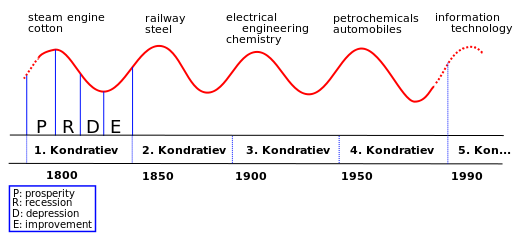
A rough schematic drawing showing growth cycles in the world economy over time according to the Kondratiev theory. Graphic by Rursus on wikimedia commons.
The start of each long cycle is synonymous with the rollout of new technologies; the rise of new business models; new countries dragged into the global market; and a rise in the quantity and availability of money. The current cycle of course is synonymous with the information technology revolution that sprung up in the early to mid nineties with the introduction of the internet and the world wide web and the absorption of the former Stalinist empire and China into the global market.
However, according to Mason, this cycle has terminally stagnated because of two things: Neoliberal policies that rapidly de-industrialised the west and increased investment in risky speculative markets; and the nature of information technology which brings the marginal cost of reproducing information close to zero – thus making it possible for vast amounts of products to be easily reproduced for free. Couple that with the decline in employment due to increasing automation of industry plus a rapidly declining population in the west and thus a decline in sources of income for state exchequers, and the shadow of a future pension crisis looms within the next thirty years or so – and the future of capitalism does indeed look grim.
Or the end of the world?
Of course, talking about the future of capitalism and the possibility of a post-scarcity egalitarian post-capitalism, would be pointless without mentioning the rather large elephant in the corner of the room – the looming environmental catastrophe that could wipe out a significant portion of the world’s population and eventually lead us to extinction and perhaps that should have been Paul Mason’s starting point. The situation is so bleak, that according to a recent article in New Scientist, “Parts of the Middle East, including the Gulf states and Muslim holy places around Mecca, could become uninhabitable even for the young and fit before the century is out, according to a new climate modelling study. The rituals of the Hajj, during which up to 2 million Muslims pray outdoors from dawn to dusk, would be impossible in summer” and sea level rises could leave major coastal cities and towns under water by the 2080‘s.
In Syria, the long drought between 2006 and 2014 was a contributing factor to the civil war that has devastated the country and drawn the oil hungry big powers into the conflict. The water shortages and crop failure brought on by drought, caused an influx of families from rural background into the cities placing pressure on services and food scarcity due to the decline in availability of arable land. In the short term, as much of the middle east experiences water scarcity and agricultural collapse, water and food shortages, combined with growing religious sectarian tension, and imperialist interest in the region’s oil supply, conflict will intensify. The cradle of civilisation could also prove to be it’s coffin, as war and terror spreads out to the rest of the world.
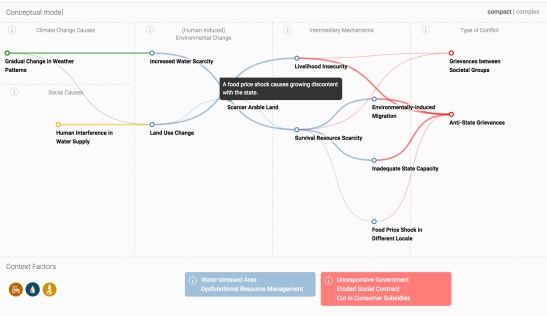
Syrian Civil War: The Role of Climate Change Graph from ECC platform library
In the long term, things could be much worse than that. “Yvo de Boer, who held the U.N.’s top climate position until 2009, remarked recently that “the only way” negotiators “can achieve a 2-degree goal is to shut down the whole global economy” (Naomi Klein, This Changes Everything). The world economy relies on growing profits, which in turn relies on increased carbon emissions. In 2015 the top ten oil companies had a net worth of 1,634.4 billion US dollars. A large proportion of this value is based on fossil fuel reserves held by these companies, which if burned will release 2,795 gigatons of carbon into the atmosphere, which is just under five times the amount that can be released between now and 2049 to keep warming beneath the magic two degrees Celsius needed to stall runaway climate change. Needless to say, that keeping these reserves in the ground would collapse the oil giants and send the global economy into a probable terminal spiral.
Paul Mason highlights the absurdity of attempting to reduce carbon emissions while sticking with a global market system; “Rising energy prices are a market signal. They tell energy firms that it’s a good idea to invest in new and more expensive ways of finding carbon.” He correctly points out that the fates of economy and ecology are closely intertwined and that an irrational market economy will lead to environmental devastation that will, in turn devastate the economy. The second half of the century, if it is a time of increasingly erratic hurricanes and typhoons and above average sea level rises, will severely disrupt our ability to create stuff, to provide for peoples’ needs, which in turn could lead to a further breakdown of society, the kind of which we are already seeing in the middle east.
But sadly, Paul’s solution to the climate crisis is to appeal to the state to take charge. States across the world have had every opportunity to impose themselves on the market and demand an ecological economy. The recent Paris climate talks, the latest in a long series of summits that include the grand fiasco that was Kyoto, came up short of producing a plan to control carbon emissions. As Jerome Roos wrote in ROAR, “Nowhere in the agreement do governments stipulate the steps they will take to meet their ambitious target of keeping global temperatures “well below 2°C above pre-industrial levels and to pursue efforts to limit the temperature increase to 1.5°C.” This is because not only are the fates of economy and ecology intertwined, but so to the fates of capitalism and the state. One relies on the other for it’s existence; The state protects and enshrines the rights of private property, while capital provides the state with income. There are bigger reasons why the state is not a solution, but we’ll come back to that later when discussing Paul’s overall solutions. First, there are some questions to ask of his analysis of capitalism and it’s demise.
Death agony or Gallifreyan regeneration?
The Russian revolutionary, Leon Trotsky wrote in his 1938 work, The Transitional Program (The Death Agony of Capitalism and the Tasks of the Fourth International):
“The economic prerequisite for the proletarian revolution has already in general achieved the highest point of fruition that can be reached under capitalism. Mankind’s productive forces stagnate. Already new inventions and improvements fail to raise the level of material wealth. Conjunctural crises under the conditions of the social crisis of the whole capitalist system inflict ever heavier deprivations and sufferings upon the masses. Growing unemployment, in its turn, deepens the financial crisis of the state and undermines the unstable monetary systems. Democratic regimes, as well as fascist, stagger on from one bankruptcy to another.”
Had Trotsky lived to see the end of the Second World War he undoubtedly would have seen, as any observer today can, that not only did capitalism survive, but it thrived to an extent that it never had before. He would have been forced to admit what so many of his followers have been reluctant to, that he was wrong. Europe and Asia, ruined by war, were prime targets for investment and the USA, with it’s infrastructure intact, was in a prime position to provide that investment. New technology, automation, increased productivity became the norm and growth soared for two and a half decades. When the long boom came to an end amidst the 1973 oil crisis, Trotskyists once again predicted the death agony of capitalism, but instead, capitalism once again regenerated, it became something very different looking, while remaining the same beast.
Paul Mason does, at length, recognise the ability of capitalism to survive the prophets of it’s demise over and over again. He describes how Marx was wrong about the immanent demise of capitalism, how he “could not take into account the major phenomena of the twentieth century – state capitalism, monopolies, complex financial markets and globalisation.” Then, he describes how by 1898, “Rosa Luxemburg was predicting that, once the system ran out of markets to exploit, there would be ‘an explosion, a collapse'”. Rosa, like Marx and Trotsky, was wrong about Capitalism’s demise as she failed to see the possibility of the state stepping in and taking control of the market. It is important to ask, therefore, if capitalism can survive this new ‘death agony’, or if it can regenerate, like The Doctor of Gallifrey.
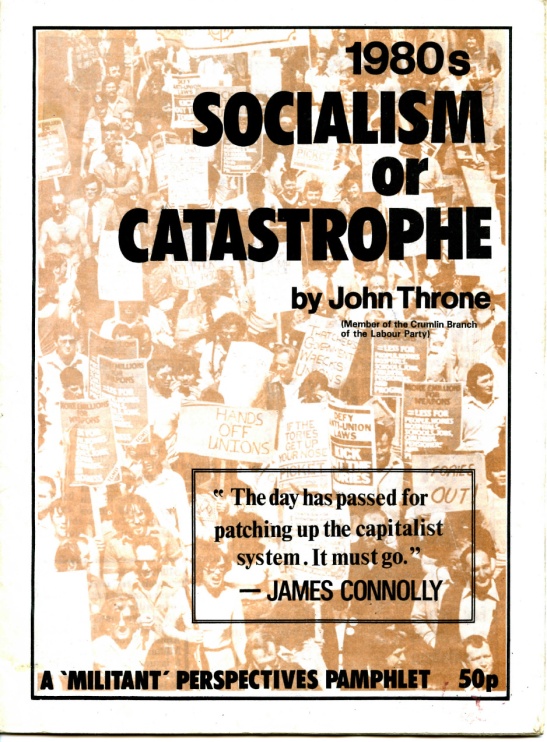
“The period ahead offers two clear alternatives. Mass poverty, starvation and nuclear annihilation if capitalism and stalinism continue, or an end to poverty, want insecurity and the threat of war on the basis of the working class taking power and establishing a world federation of socialist states.” 1980s Socialism or Catastrophe – John Throne, ‘Militant’ Perspectives Pamphlet, Militant Tendency/Irish Labour Party, 1982
History illustrates how capitalism thrives on crisis. A system for whom growth and consumption are as oxygen and water are to the human body, does best when there is destruction to rebuild from. At the height of the Spanish revolution in the 1930’s, Durruti said that the anarchists were not afraid of ruins, that they had a new world in their hearts, but not only do capitalists not fear ruins, they welcome them and they purposely destroy so they can rebuild. The war in Iraq for example, was not just about oil, or installing a regime more pliant to the demands of the USA, but also about opening new markets, business opportunities, as illustrated by the website Rebuilding Iraq which “provides business intelligence and information covering all sectors of industry including communication, construction, defense, finance, oil and gas, power, telecom and transport.”
“Like Russia’s gangsterism and Bush’s cronyism, contemporary Iraq is a creation of the fifty-year crusade to privatise the world. Rather than being disowned by its creators, it deserves to be seen as the purest incarnation yet of the ideology that gave it birth.”
― Naomi Klein, The Shock Doctrine: The Rise of Disaster Capitalism
Capitalism’s prospects of survival, if we are to take the possibility of human extinction out of the equation for a moment, can only be boosted by the veritable banquet of crisis scenarios stretching out into the future. If it is possible, the major powers will create twenty new Iraq’s, new Syria’s and destroy not only their economies, but the resolve of their people to resist the commodification of every aspect of their lives. A third world war in which a quarter of humanity was wiped out and another quarter was left destitute would be good for the markets, as long as at least one major power was relatively unscathed by the conflict as the USA was after the Second World War. And the technology developed during such a war could go some way towards kickstarting a new Kondratiev wave.
The environment is a spanner in the works though. If we pass the tipping point of runaway climate change, the planet will be heading towards oblivion, never mind capitalism. The best bet for a resurgent capitalism to reverse climate change seems to be the development of nuclear fusion as an alternative energy source. Fusion, in theory, is clean and safe, but more importantly for capitalism, it would is easy to control via traditional private property ‘rights’. Renewables like wind and solar hold the disadvantage for capital of being easily decentralised and socialised. Making fusion a viable option though, may well take longer than we can afford. The preferred option of stalling the climate crisis for the rich and powerful, is geo-engineering, a series of untestable plans to remove carbon from the atmosphere, some replicating the effect of erupting volcanoes to absorb heat. Of course, a war that destroyed much of the world’s industry and infrastructure would temporarily reduce carbon emissions too. The capitalist class would rather take wild gambles on our lives than give up it’s wealth and power. Of course there could be other scenarios where capitalism survives that are difficult to foresee at the present time. History is pear shaped; There are long periods where you can see most of what is ahead, but at times of crisis, there is a sharp curve that obscures the narrowing path.
A new economic paradigm
“Those species which best know how to combine, and “to avoid competition, have the best chances of survival and of a further progressive development. They prosper, while the unsociable species decay.”
Pyotr Alexeyevich Kropotkin, Mutual Aid a Factor of Evolution
Paul Mason’s post-capitalism, his alternative socio-economic paradigm, takes as it’s starting position the shatter-point of early twenty first century capitalism, the internet. Citing Yokai Benkler’s The Wealth of Networks, he writes, “the rise of cheap physical computing power and communications networks had put the means of producing intellectual goods into the hands of many people”, which leads to the rise of non-market mechanisms: decentralised action by individuals, working through cooperative, voluntary forms of organisation.” Wikipedia is the prime example; It has 8.5 billion page views per month with twelve thousand regular contributing volunteers. Wikipedia is a non-profit entity and it’s existence as a free to use resource has pushed the market out of the encyclopedia game. Seriously, when was the last time you saw a set of World Book or Brittanica on someone’s bookshelves?
Even within the world of e-commerce, the biggest corporations thrive by capturing, what Paul calls, “good external side effects”. Amazon sells you stuff based on information you provide for free, Facebook sells your data to third parties; For Amazon we are both workers and consumers, for Facebook we are just workers who produce what they sell to other corporations. Supermarkets also collect huge amounts of data from us and “by aggregating it’s data and preventing it’s utilisation by anyone else (they) gain a huge commercial advantage.” He ponders the societal advantage if this data was available to everyone, how producers and consumers would be able to make more informed decisions. Here we see close up how the capitalist mode of production and it’s form of property, intellectual property in this case, is a fetter to the further advancement of the possibilities that infotech has laid before us.
It is important to recall however, that this struggle between the commons and private property is not a new development. For aeons, people have attempted to claim and privatise resources that were previously the common property of all, while others fought back. A modern example is the commodification and privatisation of water resources throughout the world and the battles that have been fought against that with varying degrees of success, from Bolivia, to Detroit to Ireland. The temporary occupation and use of public space by the occupy movement, the 15M and the arab spring, notably the battle over Gezi Park in Turkey are further iterations of this war, as is the reclamation, repair and use of empty buildings by squatters and state and private security attempts to dislodge them.
The difference with the development of infotech and the old battles of the commons is that this technology gives us the opportunity to organise an entire commons based economy that is decentralised and federal in nature. It gives us the chance to practice mutual aid on a global scale. The advent of 3d printers will allow communities to download and print components to build houses, equipment and other things they need; Instructional videos can give people skills they would have had to take expensive classes for before; And the socialisation of the kind of data that supermarkets and other retailers collect would allow us to accurately predict what goods and services we need to produce to satisfy people’s needs. All this would allow us to produce enough and get rid of the colossal waste that the private use of this data and the capitalist drive for profit creates.
But there is a shortcoming in Paul Mason’s analysis; The capitalist class will not just stand by and allow us to break it’s monopoly on intellectual property anymore than it will stand idly by as we reclaim buildings and public space. The new mode of production may grow within the old but it always requires force of some kind to cement it’s ascendency. The capitalist class thrived for a time under monarchies and coexisted with feudalism, but eventually it required revolutionary action when the old order of things held back it’s development. The wealthiest one percent and their subjects are engaging us in class war and if we don’t fight back, they will fence off our commons and make us pay to use it. The downfall of Napster, the constant attempts to shut down free television streaming sites and the rise of bill pay music and TV streaming services are illustrative.
Masses against classes
“Today, the whole of society is a factory – and the communication grids vital for everyday work and profit are buzzing with shared knowledge and discontent. Today it is the network – like the workshop 200 years ago – that cannot be silenced or dispersed”
Paul Mason – PostCapitalism: A Guide to Our Future
But who is this we I speak of? Are we the 99%? Are we the proletariat, the classical working class? Are we a mish mash of heavily stratified classes as outlined by Guy Standing in his book The Precariat? Are we, as Paul Mason suggests, “the educated and connected human being(s)”? Or are we something else? I’ll be returning to the subject of class in some depth in part three of this series, but for now, let’s briefly consider what both Marx and Kropotkin meant by class and how that fits with a picture of today’s society. For the early classical communists, both Marxist and anarchist, capital is seen as ‘dead labour’, the product of work by generations accumulated in property or monetary form. The proletariat, or working class, sell their labour, the capitalists profit from it and accumulate that profit as capital. In this respect the vast majority of people today qualify as proletarian, but there was a specific part of this class that Marxists and Anarchists were interested in, the industrial proletariat.
The industrial proletariat was seen as the motor force of the revolution, the revolutionary subject who had at it’s finger tips the skills and power to expropriate the capitalist class. Because it was that section of the working class who operated the machinery that built the commodities that would make communism possible, because the capitalist class could not do without them, they were seen as capitalism’s grave diggers. They could bring the entire economy to a halt by going on strike and they could restart the machines under the control of their own workers councils to build a communist society. This is important because it is a distinction that is often forgotten by modern day leftists who often talk about the working class in the sociological sense (See Owen Jones – Chavs) that is more akin to social caste and says more about how classes are stratified than their relationship to the means of production. It’s not that social caste isn’t an important factor in building an anti-capitalist movement, but that the two conceptions of class need to be separated, for the relational concept, preferred by the early Marxists and anarchist communists, has implications for the process of revolution. It holds within it transformational potential, the key to the abolition of property and class relations.
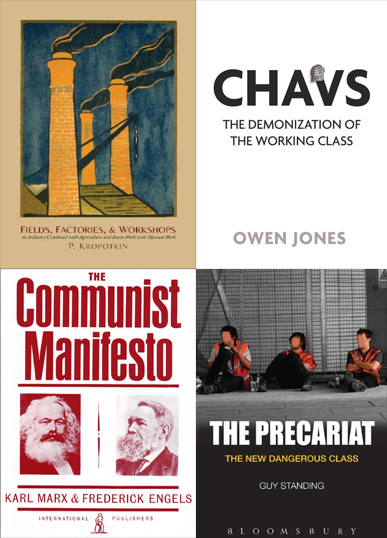
Relational versus Sociological Views of Class
Paul Mason describes the early 21st century’s agent of change as “the educated and connected human being”, but this doesn’t tell us much in relation to class, that could describe a member of the capitalist class, the middle class or the working class. Even those without a high level of formal education, in the infotech age can attain a high level of knowledge, it is the age of the digital autodidact. However, what relationship to the means of production do those who most embody the revolutionary potential to abolish capitalist economic relations hold? Most of them, in the strict waged worker sense of the term can still be classed as proletarians, but it is not especially in their workplace (except in those countries where the industrial proletariat is still a force) that they pose a threat to private property and capital.
It is in their ability to work in a collaborative voluntary manner, on line and off. In this sense they could be termed ‘the communist class’ because their economic and social relations with each other and those who use what they create are communist, not because they are ideological communists. However, as most of them have a proletarian relationship to capital, they can not be seen as a fully formed communist class. Even in their voluntary online endeavours they can be exploited – linux is an open source computer operating system, but android, Google’s smart phone operating system uses it as it’s template; Facebook users are constantly producing value for the social media giant and the companies they sell our data to – so this is a class in transition. It simultaneously embodies two separate and opposite class relationships and it should properly be called the ‘communist proletariat’.
The task of the communist proletariat in the revolutionary process is threefold. Firstly, they broaden the new social relations alongside capitalist relations – shrinking the market, growing a new society within the old; Secondly, wearing their proletarian hats, at the moment when the two systems can no longer live beside one another, they will bring capitalism to a grinding halt by withdrawing their labour in a revolutionary general strike – or they will gradually cease working for capitalists as their own society flourishes. They will then have to dissolve capitalist state power. Finally, when they have transitioned form being the communist proletariat to the communist class, they will manage whatever is still necessary of the old economy in a democratic manner until those structures are no longer needed and they cease to be a class, as class ceases to exist as a hierarchy of social relations.
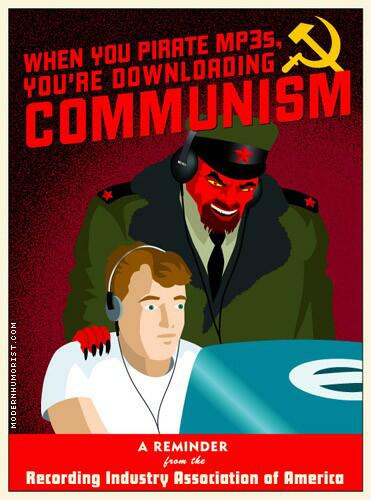
The invisible hand of communism
“All is for all! If the man and the woman bear their fair share of work, they have a right to their fair share of all that is produced by all, and that share is enough to secure them well-being. No more of such vague formulas as “The right to work,” or “To each the whole result of his labour.” What we proclaim is The Right to Well-Being: Well-Being for All!”
Pyotr Alexeyevich Kropotkin, The Conquest of Bread
It’s around this issue of class relations and the need for revolutionary change that my analysis diverges from Paul’s. We could possibly clumsily gloss over the issue of class recognition, lie for the sake of unity and say it’s a matter of semantics, but after point one on the role of that class, our visions become radically different. Whereas I envisage the complete abolition of wage labour, the state and monetary exchange, he sees uses for government, the private sector, and money and banks. But, he writes, “I have tried to make this a project usable by both people who see states as useful and those who don’t; you could model an anarchist version and a statist version and try them out.” As a matter of fact, modelling an anarchist communist version of PostCapitalism is what I am attempting to do here.
Paul’s PostCapitalist society rests on three pillars, the cooperative economy, the state, and finance. But after reading his lengthy descriptions of peer to peer open source voluntary work, putting it alongside money and the state kind of jars. The role of money ultimately for Paul Mason is bound up with the maintenance of a private sector in the transitional phase. But the private sector, like the state, cannot continue by shrinking. If capital loses it’s power and profit, it will withdraw and the goods and services that we rely on will become scarce. At this point, communities would have to decide whether to give up on the experiment and go back to capitalist property relations or eradicate capitalism altogether.
Paul admits that “credit creation only works if it makes the market sector grow – so the borrower can repay the loan with interest. If the non-market sector begins to grow faster than the market sector, the inner logic of banking would break down.” Money is a social technology, it is a medium of exchange, a measure of wealth, an method of accounting for the goods and services in society and for the extension of credit. However, it is a social technology that most belongs to a specific kind of society, one that is based on private property. A new society based on communistic economic relations will need it’s own technology that will not allow wealth to be hoarded, can give a real time snapshot of the number and location of products, that will be able to predict what goods and services are needed by society and will regulate the general production without interference from planners, and creates “new values, behaviours and norms” with minimal effort. That technology already exists and is being used for a multitude of tasks.
Erik Brynjolfsson and Andrew McAfee write in The Second Machine Age: “Tweets were just as accurate as official reports when it came to tracking the spread of cholera after the 2010 earthquake in Haiti; they were also two weeks faster… social media expresses a collective wisdom which, when properly tapped, can yield an extremely powerful and accurate indicator of future outcomes.” Then there is Waze, an application that both gives you GPS driving directions and uses realtime traffic information provided by users to help you avoid traffic. Waze combines different kinds of information to do this. It receives your GPS location, it tracks your speed, and can also receive specific user input about traffic, for example you could say there was a police checkpoint or just tag a particular section of road as having particularly heavy traffic.
As every individual, therefore, endeavours as much as he can both to employ his capital in the support of domestic industry, and so to direct that industry that its produce may be of the greatest value, every individual necessarily labours to render the annual revenue of the society as great as he can. He generally, indeed, neither intends to promote the public interest, nor knows how much he is promoting it. By preferring the support of domestic to that of foreign industry, he intends only his own security; and by directing that industry in such a manner as its produce may be of the greatest value, he intends only his own gain, and he is in this, as in many other cases, led by an invisible hand to promote an end which was no part of his intention. Nor is it always the worse for the society that it was not part of it.
Adam Smith – The Wealth of Nations
To see how we might allocate and account for goods and services on a communist basis, we just have to look at existing technology and join the dots. An application like Waze with a barcode scanner that used GPS location could take a realtime snapshot of what was being taken from stores and consumed in a given location at a given time. You could take your weekly shop from the store, scan the barcode as you unpacked it then scan again when the item is consumed – people already do similar things with health apps to track their diets. This, combined with ‘wish lists’ would give an accurate picture of peoples’ needs and desire and would be not skewed by price mechanisms. People would take the things from the store they actually want, not what they can afford. Production would be regulated, not by the market, not by central planning, but by the sum total of decisions made by individuals in the pursuit of their own needs, wants and happiness – the invisible hand of communism.

Photo by John Blyberg on flickr
Post-Hierarchy: Fight for Our Future
“A strong State can have only one solid foundation: military and bureaucratic centralisation. The fundamental difference between a monarchy and even the most democratic republic is that in the monarchy the bureaucrats oppress and rob the people for the benefit of the privileged in the name of the King, and to fill their own coffers; while in the republic the people are robbed and oppressed in the same way for the benefit of the same classes, in the name of “the will of the people” (and to fill the coffers of the democratic bureaucrats). In the republic the State, which is supposed to be the people, legally organised, stifles and will continue to stifle the real people. But the people will feel no better if the stick with which they are being beaten is labeled “the people’s stick.”
Mikhail Bakunin – Statism and Anarchy
Both Paul and myself enjoy something that can easily skew our view a little – white male privilege. This can make it easy to overlook other oppressions like gender, race, sexuality, and social caste. These oppressions don’t stand alone as single issues, separate to each other and separate to class exploitation – they intertwine creating a complex web of hierarchy, that though, myself and Paul as people who have been involved in left wing activism for decades are well aware of, we never feel their full effect, but it’s important to remember that forging a world where everyone is equal and everyone is free requires us to fight against all of these as well as the economic side of capitalism. For reasons of space, I won’t delve deeply into those here, but will return to the subject later in the essay on movement building. There is also the fact that I, being a white cis gender heterosexual male, am not all that qualified to write on these subjects.
The state however, with its police and army, and its sprawling bureaucracies, armed with balance sheets and statistics, acts like it has the right to decide what is good for all. Anyone who has been involved in radical political activism, especially in the current climate, will have experienced all of these arms of the state acting to protect interests who act for the benefit of capital and the elites within society. They instinctively recognise the fact that these forces are not there to protect us, they exist to protect the state and capital from us. Even where socialists take over the state, the aim is to consolidate their power over everything else and they will do this at the expense of groups they claim to represent.
History is littered with examples – the crushing of the Kronstadt revolt, strikes and opposition socialists by the Bolshevik government in Russia; the betrayal of the revolution in Catalonia and Aragon by the Stalinist lead republican government during the Spanish Civil War; the Labour government in Britain using the army to break strikes (more times than the Tories in fact); the SYRIZA government in Greece administering the austerity they swore to fight – and there is no reason to believe that government can ever be anything other than the maintenance of state power which translates as the protection and defence of the dominant strata in society against workers, against the poor, against women and against ethnic minorities.
But even purely for the purpose of transitioning between capitalism and post-capitalism, it makes no sense to try to keep the state in a society built on the economic foundations of voluntary, open source, collaborative activity. Paul even writes that states are in serious economic difficulty. In Europe, an ageing workforce means that pension funds will dry up and tax revenue will fall. He reckons that the shortfall can be made up by increasing tax on corporations, but if we are encouraging the shrinking of the private sector then there will be less to take, even if the rich were willing to sit back and let us take it. The state is snookered, it needs revenue and it can only get revenue from one of two ways – taxation of individuals and corporations or nationalisation and a state run centralised economy – and both need the suppression of communist economic relations if they are to thrive.
A non hierarchical economy requires a non-hierarchical society. What form that takes will be decided by the people of that society, but we can hazard a guess at what that might look like. At community level there could be regular face to face assemblies to decide local matters, communities could federate to form regions, and regions to form super regions. Between assemblies infotech could be used to make decisions. We need to shake off the baggage of class society if we want build a future where the well being of all is the primary motivation.
If you would like to see my opinions on politics, football, science and technology, or dogs, you might like to follow me on twitter
Communism versus The Commanding Heights Contents
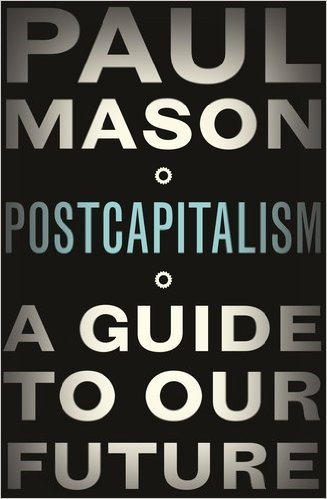
PostCapitalism: A Guide to our Future by Paul Mason is well worth reading btw. I disagree with some of it but there’s a kind of outside the box thinking you don’t often get in lefty schemas.

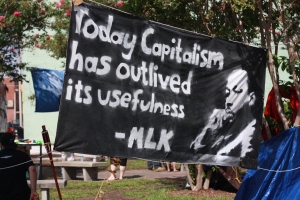
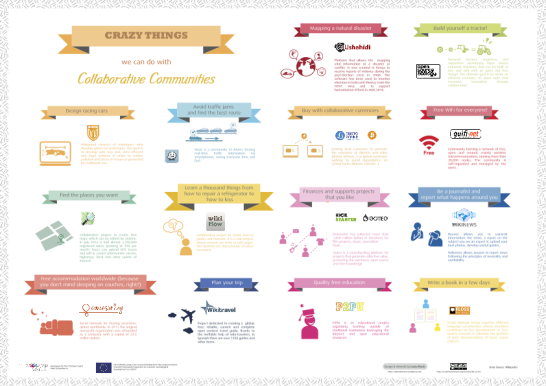
Pingback: The Old World is Behind You – How Infotech Changed The World, The Movement and Me. (Communism versus the Commanding Heights Part 1) | Self Certified
Pingback: The New World in Our Hearts – A Critical Engagement With Paul Mason’s PostCapitalism (Communism versus the Commanding Heights Part 2) — Self Certified | Stiofán Ó Broin
Pingback: I have seen the techno-future, and I’m not so sure it works | People and Nature
Pingback: Six Reasons Why Universal Basic Income is a Bad Idea #dabf | Self Certified
A true post-capitalist society has to be a commonly owned, democratically controlled, free access one.
Pingback: Socialist Alchemy can’t turn Rust to Iron – Why Bernie Aint the Answer | Self Certified
Pingback: On the Invisible Hand of Communism | Self Certified
Pingback: The Robots are Coming, Look Busy! – Automation, Work and Class (Communism versus the commanding heights Part 3) | Self Certified